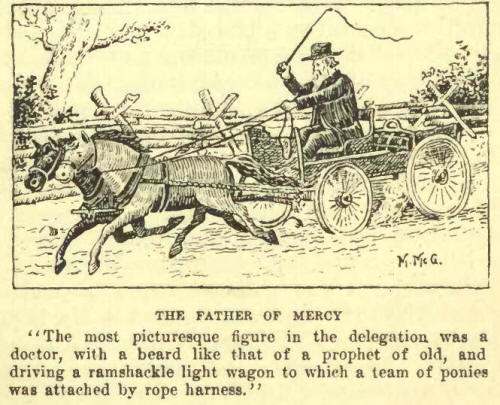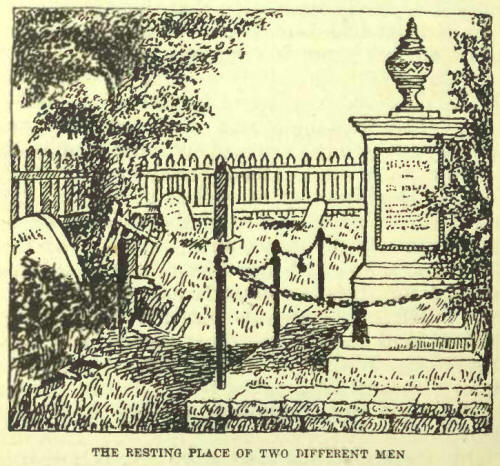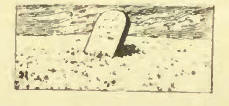|
THE BLACK FLAG OF DEATH
"At the time my father
came to Canada in 1832, a plague of cholera was sweeping through the
land and the only activity was in the cemeteries."
This statement was made
to me by Henry Morris, of the township of Colborne, Huron County. An old
newspaper clipping of the early thirties, preserved by Mr. Morris,
showed that he had not exaggerated in his description of the situation.
In this clipping it was stated that the entire country along the line of
the St. Lawrence frontier, for a distance of five hundred miles, was
being scourged by the plague and that the "mortality was enormous."
Seigneurs, judges, members of the Legislature, doctors, men of all
degrees were stricken. Among the notable victims were the Hon. John
Caldwell and Judges Taschereau and Kerr. The city of Quebec was in a
state of terror, business was suspended, people shut themselves in their
homes to escape contagion, and plague flags, more ominous than the red
emblem in parts of Continental Europe to-day, flew everywhere. In
Montreal out of a population of twenty-five thousand at that time, there
were one thousand deaths. In the whole colony it was estimated that half
the population was attacked and that one in every twenty-seven of the
people died.
The situation was made
worse by the refusal of the crews of many lake and river steamers to
operate the vessels, and by the action of people everywhere in barring
their doors against emigrants then streaming into the country, and who
were blamed for bringing the cholera with them. The emigrants' cup of
sorrow was filled to overflowing when, seeking to escape to the United
States, they found the American militia lining the border to prevent
entrance.
"It was," said Mr.
Morris, "under circumstances such as these that my parents arrived at
Quebec. They had with them an infant child that took sick on the way.
While on a river steamer coming up the St. Lawrence the child died; and
in order to conceal death, and so avoid having the body thrown
overboard, my mother held the dead body in her arms for twenty-four
hours, until Prescott was reached, and there Christian burial was
secured.
"There was just one
bright spot in a situation that otherwise was one of universal gloom.
While the plague was at its height a delegation came over from New York
to assist the stricken. The most picturesque figure in the delegation
was a doctor, with a beard like that of a prophet of old, and driving a
ramshackle light wagon to which a team of ponies was attached by rope
harness. This doctor made but the one request as lie journeyed over the
plague-smitten territory, that he be shown where the worst cases were to
be found. When he arrived on the scene of suffering his remedies were of
the simplest—powdered charcoal, maple sugar, and lard administered
internally; with lye poultices, made front wood ashes, and as strong as
the patient could stand, applied externally to relieve the cramps from
which cholera patients suffered. In no case would this Father of Mercy
accept fee, but after his service was ended a fund, raised by public
subscription, was forced upon him. That nameless American doctor of the
'thirties was the Hoover and more than the Hoover of his day."

Mr. Morris had to draw on
what he had heard from his parents, or read in an old newspaper
clipping, for what he told me. From Henry Smith, of Barrie, interviewed
a month later, I received a first hand story, not only of the
devastation caused by cholera outbreak, but of the equal calamity due to
ship-fever which occurred some thirteen years afterwards.
"I was in Montreal when
the cholera was at its worst," said Mi. Smith. "As people were dying by
thousands no time was taken for funeral ceremonies. The dead were buried
by contract on the basis of so much for each corpse disposed of. The
bodies were hauled away in carts and dumped in great trenches as the
killed are laid away after battle. I believe many were buried while
merely in the state of stupor that resembles death. Those immigrants who
had not been attacked were held in quarantine in great barn-like
structures. The sick were housed in buildings of like construction and
with little more by way of comfort. An immigrant told me that as their
ship was coming up the Gulf of St. Lawrence they saw, dotting the sea
for miles, bedding that had been thrown overboard and on which
fever-stricken emigrants had died.
"I was in Piston when
ship-fever came later, and as I was attacked by that disease myself, I
saw little of what went on during the worst of the plague but I was
witness of the effects afterwards. The sufferers were housed in sheds
and a nearby cemetery was largely filled with those who died. Then,
after the plague had apparently been brought under control, the disease
was carried in the clothing of immigrants to farm houses in which
employment had been secured. Children seemed to escape the fever, but
among the immigrants, as well as the farmers who had employed them, many
children were left orphans and many women widowed.
"The question then arose
as to what was to be done with immigrant orplians and widows. They could
not be sent back and could not be left uncared for here. I.t was at this
juncture that Bishop Straclhan came to the rescue with. heroic remedies.
I-Ie had the orphaned children placed in foster homes, and he was
credited with arranging something like forced marriages for the widows.
One well-authenticated case had to do with a widow who had considerable
cash, and a local farmer who had much land but no money and no wife. The
bishop had banns proclaimed between these two, and it was not until
after the proclamation that the widow was told of what had been done.
She was further informed that banns having been published, the marriage
must of necessity be gone on with and she was ordered to prepare for the
same forthwith. The inevitable was accepted and the union appears to
have turned out quite happily."
There were some Good
Samaritans at the time of the ship-fever as well as at the time of the
cholera plague. Some of the stricken ones among the Irish immigrants
having reached Newmarket, an old brewery was turned into a hospital for
their accommodation. Volunteers were called for to nurse the patients
and Wright Burkett and a harness-maker named Wallace responded. While
engaged on their service of mercy, Burkett contracted the fever and
died, and Wallace was brought to death's door but recovered.
The facts in this case
were given me by John Langstaff at the time he told the story of the
tragedies of Yonge Street due to early drinking customs.
WHERE HEROES LIE
I've tried to portray with
the aid of the pen
The last resting place of two different men,
Divergent in life, one humble, one great,
They both passed in death through the same little gate.
Neath six feet of earth they now lie asleep;
Their friends and their neighbours have long ceased to weep;
The hoarse blasts of winter hurl snow o'er the ground,
The soft summer zephyr caresses each mound;
In nature's embrace no difference they find,
It leaves class distinction to fickle mankind.

We learn from the obelisk
reared to the sky,
Resplendent in grandeur, impressing the eye,
That a lofty man lies in the clay damp and cold,
If we read the inscription in letters of gold;
The plot claims attention, the grass is kept shoran,
The sweet blooming flowers are trained to adorn.
The neat iron railing, loop, tassel and fret,
Are painted and varnished the colour of jet;
The lilac in season of beauteous bloom
Ne'er fails to contribute her fragrant perfume.
We turn to the other,
neglected it stands
And hence to its fellow more beauty it lends:
The mound it has settled, the slab has a lean,
While round it the weeds in profusion are seen,
Which seem as they sway by the autumn wind blown,
In affection to burnish the face of the stone,
O'er the grave of a poor simple knight of the soil
Released from his thraldom of trouble and toil,
Who played well his part when the country was young,
And now lies forgotten, unhonoured, unsung.
—M. McGillivray
Here and there through
these stories reference has been made to occasions, when in summer's
heat or winter's cold the first settlers laid the bodies of their loved
ones in ground forever hallowed by the labours of the dead and the
living. In many cases these burials marked the beginning of cemeteries
that have since been maintained by descendants of the original settlers
who still live in the neighbourhood. In cases without number a different
story must be told. Some of those who died in the early days were
without relatives in this country and no one was left, even from the
first, to care for the lonely graves in which they were laid. A typical
case was that of which my old friend Larry Smith, of Whitby, once told
me. Pointing to two or three field stones irregularly embedded on the
bank of a stream on his own farm, he said that these marked the last
resting place of two strangers who had fallen victims to the cholera
plague, which swept the province in the early part of the last century.
As noted already, burials of necessity followed promptly on death in
such cases, and one of these victims heard the sound of his coffin being
nailed together before his eyes closed in the last sleep. In thousands
of instances descendants of those who fell by the wayside, inheriting
the wanderlust to which the creation of Ontario was in no small part
due, followed the moving horizon beyond which the star of hope always
beckoned, and the result is that to-day almost every township in Old
Ontario has at least one cemetery in which the names of the dead are
those of strangers in a strange land. The descendants of the pioneers
have themselves passed to the beyond, or are scattered all the way from
the Gulf of Mexico to the polar seas and no one is left to care for
these resting places.
In the closing year of
the last century I visited one such cemetery in the township of
McGillivray, near where Maple Lodge post-office then was. Not one of the
descendants of those lying in this cemetery were then living in the
neighbourhood, and sheep were pasturing among the broken or falling
monuments.
One broken slab had been
erected to the memory of "Rebecca, daughter of—." This was all that
remained of the inscription. Another headstone marked the spot where lay
the body of a little son of William and Jane Barber, who was carried off
in 1846, at the tender age of one year, six months, and fourteen days.
One could imagine the grief of the broken-hearted parents as, amid the
gloom of a forest varied only by the blackened stumps of the scanty
clearings, the body of the little one was laid in the damp ground.
Particularly pathetic, too, was the blurred lettering over the grave of
Alonzo Barber, born in 1858 and died in 1859. All that could be
deciphered of the lettering in this case was:
" ................ Little
Stranger
..................Stay.,
But there was a world of
pathos in those three words.
These scattered graves
and neglected cemeteries of the unknown dead are but gloomy reminders of
man's mortality. They serve no real purpose, and it would be more in
keeping with what is due to those who blazed the trail into the forest
and laid the foundations of a prosperous province, if the broken
headstones were wholly removed. Fields of waving grain or the rich bloom
of orchards growing in their place would in some measure remind those
with ears to hear and eyes to see, of the inestimable services rendered
by the labours of the men and women who made possible the enjoyment of
the heritage of to-day.

|

